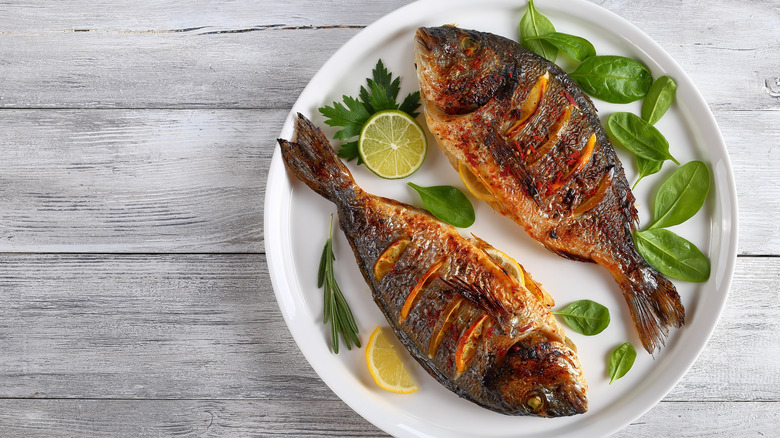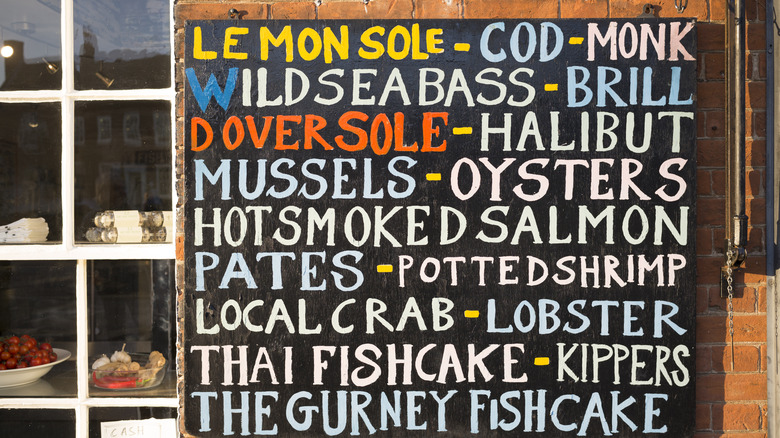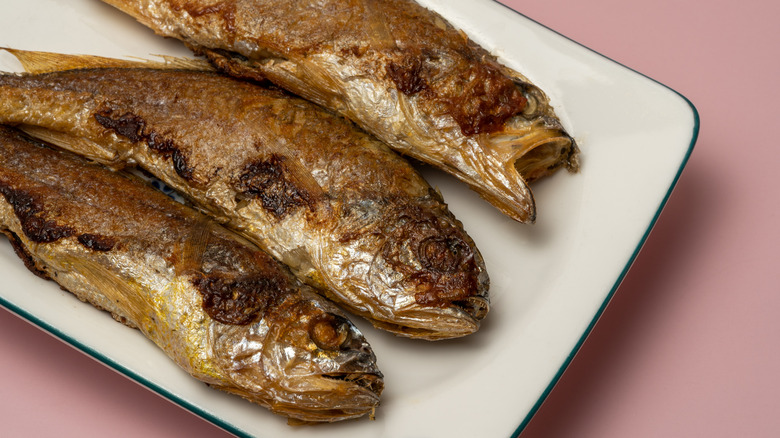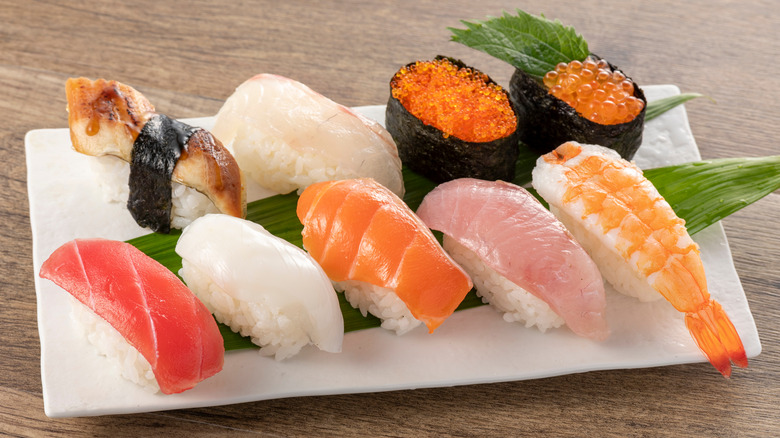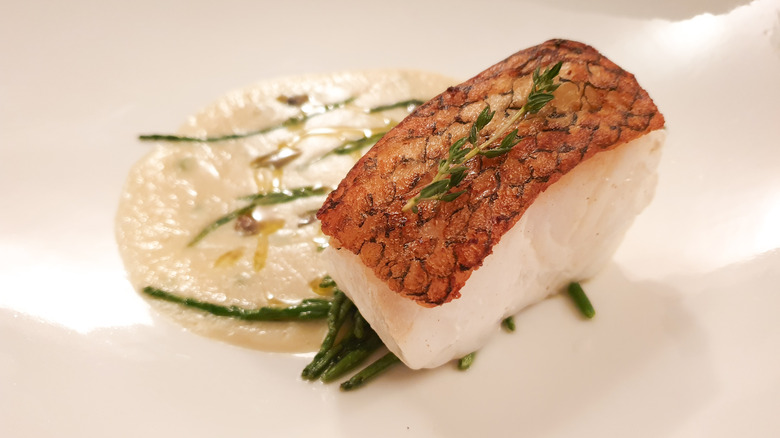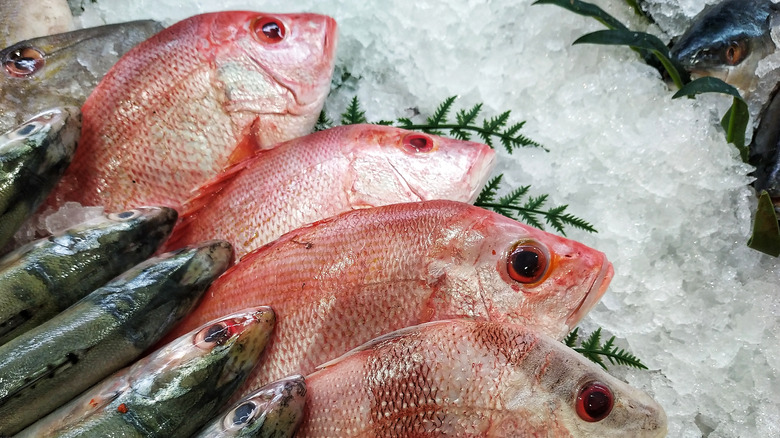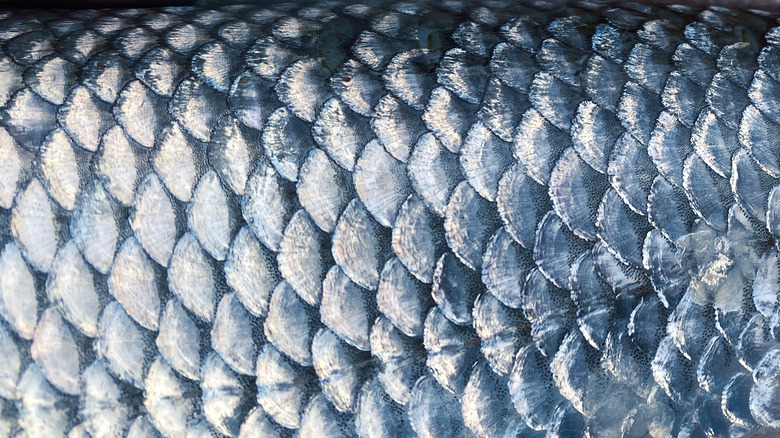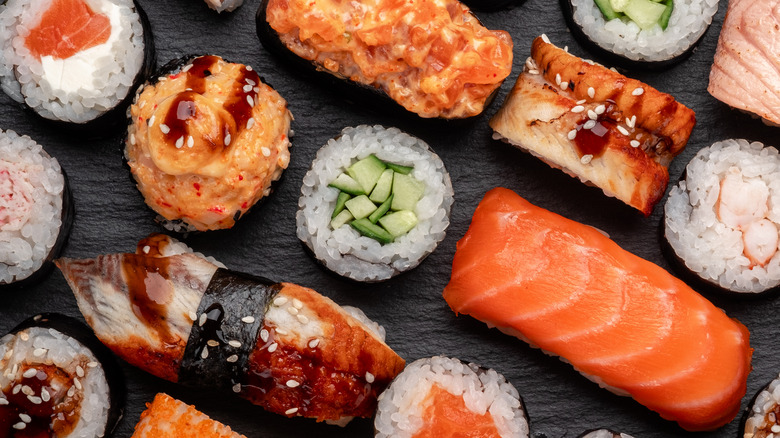Here Are The Signs You're Eating Cheap Fish
Seafood consumption in the US is at an all-time high. According to a 2020 Fisheries of the United States report released by the National Oceanic and Atmospheric Administration, the average American consumed 19.2 pounds of seafood in 2019 (via NOAA). And there's a good reason for this: Fish isn't only delicious but it's also healthy. In fact, the Food and Drug Administration recommends that we eat at least eight ounces of seafood each week. This, however, applies to quality fish that's fresh and filled with nutrients.
Not all fish dishes served at restaurants are created equal, and this statement doesn't just apply to taste. Fish can be downright dangerous to consume when it's mishandled or not sourced from reputable suppliers. Unfortunately, since around 65% of seafood consumed in the US is imported, we are often left at the mercy of the safety practices of the exporting countries. Restaurants have also been known to substitute expensive menu items for cheaper fish. Not keen to put your health and taste buds at stake next time you order fish at a restaurant? Here are a few tips to help you detect cheap fish.
The price is too good to be true
There's a saying, "If the price is too good to be true, it probably is." And when it comes to ordering fish, paying heed to these words of wisdom might just save you — and your stomach — from a substandard meal. The truth is that quality fish isn't cheap and while your local restaurant might get discounts for buying in bulk, it still needs to fork out a certain amount of cash to purchase high-grade seafood. As such, it's normal that fish is usually on the pricier end of the spectrum when it comes to restaurant menus.
If a restaurant is selling its fish dishes at surprisingly low prices, it may be substituting quality fish for cheaper alternatives. According to Oceana, a startling one-third of fish purchased in the US is mislabeled. "A fillet of rare red snapper could really be cheap tilapia. A pricey wild-caught salmon steak from Alaska could be farmed Atlantic salmon from Chile," Elizabeth Weise writes in USA Today. And here's something else to think about. After exposing a black market fishing network, the Ministry for Primary Industries in New Zealand told RNZ that it hopes people think twice about what may be hidden behind the price of the fish they enjoy at restaurants.
The fish is overly dry
Fresh high-quality fish should be succulent, tender, and juicy. There are a few reasons why your fish doesn't live up to this. Firstly, it might not be fresh. Alternatively, it might be a cheap fish that hasn't been handled appropriately. For instance, while overly dry fish can be the result of overcooking, it can also be a sign of a subpar fish that has been frozen. This is especially the case if the fish isn't flash-frozen a short time after being caught. According to Science Line, when fish freezes slowly, small crystals form in the muscular tissue cells, leading to a change in texture that may leave your dinner overly dry.
In the worst-case scenario, you might be eating fish that was previously cooked, frozen, defrosted, and reheated — something that might be more likely to happen with cheap fish. To clear things up, Epicurious decided to put three types of salmon preparation methods to the test in a blind tasting. The first fillet had been cooked, frozen, and placed straight in the oven. The second fillet had been cooked, frozen, thawed for six hours, and reheated in an oven. Finally, the third had been cooked immediately before serving. Not surprisingly, the freshly cooked fish received no complaints. The fish that was thawed and reheated was less pink and had a questionable texture. As for the fillet that was reheated from frozen, taste testers described it as "practically ashen" and "dry and unpleasant to eat."
You are eating the seafood special
While seafood specials may look great on paper, they are usually a way for restaurants to move their least popular and cheapest produce. As "Top Chef" finalist chef Silvia Barban explains, "Specials are tricky in restaurants. It could be the most fresh and delicious special, but in some restaurants, specials are the way to clean up the fridge" (via Insider). She advises restaurant patrons to check whether the side dishes that come with the seafood special are repeated elsewhere on the menu. If they are, you are probably eating fridge leftovers.
For many restaurants, seafood specials are an opportunity to get rid of older fish before it goes bad. According to Anthony Bourdain, you should be particularly suspicious of seafood specials on Mondays since most restaurants stock up on their fresh ingredients on Thursdays before the weekend rush. Since fish normally stays fresh for two days per the USDA, it's easy to imagine why this advice makes a lot of sense. And while Bourdain has since clarified that his recommendation pertained to restaurants where seafood isn't the "main thrust," you can never be too careful (via Business Insider).
The fish is smothered in spices or butter
High-quality fish should be able to stand up to the taste test with minimal preparation. As such, when it comes to seafood and meat, a heavy hand with spices or a rich buttery sauce can be a huge red flag. Although it has been thought that spices were used to camouflage the taste of spoiled meat in the Middle Ages, the fact that spices were simply too expensive at the time shuts this theory down (via Culinary Lore). Nevertheless, with today's cheap and abundant spices, there's nothing to stop modern-day restaurants from using them to conceal the flavor of substandard or old produce.
But it's not just about the taste. Restaurants can also mask the smell of deteriorating or low-quality fish by bathing them in milk. American Society of Nutrition explains that the fishy odor and flavor of aging seafood is caused by the build-up of trimethylamine — a substance that gradually increases after a fish has been caught and killed. The fishiness can be easily counteracted with the casein protein found in milk which binds to trimethylamine. And while you may not be able to taste or smell inferior fish, the dining experience may leave you stuck to the toilet.
You are eating farm-raised or imported fish
Any seafood restaurant worth its salt provides information about the origin of its fish. If this isn't the case, it's definitely worth asking where the fish was sourced. At the moment, 50% of fish sold globally is farm-raised (via NOAA). While farm-raised fish are cheaper than their wild-caught counterparts, they are usually fed inferior feed and can be loaded with antibiotics. They are also more likely to carry trace pollutants associated with inferior water conditions (via Master Class).
As a rule of thumb, avoid catfish since it is often farm-raised in Vietnam, which has different regulatory requirements than the US. One of the issues is that the import isn't usually catfish but swai fish — a type of fish called catfish in Vietnam that costs $3 a pound — which is then labeled by restaurants as more expensive offerings such as American catfish or even grouper (via Inside Edition). Organizations like the Marine Conservation Society are good sources to educate yourself on the best types of fish to be eating.
You are eating white tuna
Did you know that there's no such thing as white tuna? That's right, white tuna is a big fat lie. Popular at Japanese restaurants, so-called white tuna is often seen by patrons as a slightly cheaper option to otoro (fatty tuna) and chutoro (mid-fatty tuna). So what exactly are you getting when you order white tuna? "People hope it is albacore," says chef Yoshihiko Kousaka of New York City's restaurant Kosaka, referring to the best possible outcome of ordering white tuna. "But when you see something that says 'white tuna' and not 'albacore,' it is not albacore. White tunas are usually 'oilfish,' 'butterfish' or 'escolar'" (via Food Republic).
Many restaurants serve other fish under the misleading label of white tuna to save costs. Unfortunately, when it comes to the consumers, this practice can have rather undesirable consequences. This is because when you order white tuna, you are often served escolar, a fish known to cause gastrointestinal problems due to its high oil content. Kathryn Hill from The Kitchn explains, "to be frankly and bluntly specific — and I'm sorry for this — consumption of escolar causes explosive, oily, orange diarrhea." It's little wonder that escolar has been banned in Japan and Italy, and that it must come with a warning label in Canada, Sweden, and Denmark.
The fish isn't in season
If you want a certain type of fish at a specific time and you want it cheaply, you may be setting yourself up for disappointment. For example, if wild salmon is in season from May to September, restaurants that serve the dish in January should immediately raise a red flag. Not only are they selling frozen fish, but it's also unlikely that they care about what they are putting on your plate. And since they are showing little care when it comes to devising their menu, they may also not be very picky when it comes to the quality of their catch (via Bittman Project).
It's also not advisable to eat wild freshwater fish in summer (we aren't talking about farmed seafood here). This is because as the temperature increases, both ponds and lakes can dry out. In turn, the shrinking body of water can result in an increase in pollutants that the fish will inevitably digest. The water also tends to be more stagnant during the summer season, prompting algae growth and deterioration in water quality. This, in turn, can make fish more vulnerable to parasites and disease (via Angling Trust).
You are eating Chilean sea bass
Don't be fooled! Chilean sea bass is not what it seems to be. In fact, it's really a kind of fish known as the Patagonian toothfish. While that might not sound the most appetizing, Patagonian toothfish was once a marvel of the seafood industry. According to The Atlantic, it started hitting seafood markets fairly recently, thanks to the advent of modern fishing technology. It was cheap, pretty good tasting, and so became a smashing success in short order.
But, as Priceonomics notes, so-called "Chilean sea bass" was cleverly marketed and soon moved from fish stick to pricey restaurant menu. Unfortunately, the Patagonian toothfish soon suffered from overfishing. This particular variety was so affected by the fishing industry that it became a red-listed fish, meaning it is extremely threatened to the point of extinction. Greenpeace warns that the current Patagonian toothfish population is so threatened that it could become extinct within five years.
While The Atlantic points out that there is one fishery in the Georgian Sea that legally cultivates Patagonian toothfish, it's highly unlikely that Patagonian toothfish is what's actually being served when you order "Chilean sea bass." That's despite the fact that the U.S. remains one of the largest Chilean sea bass consumers in the world. While the name has been a workaround for many restaurants to offer the highly sought-after fish or simply a dupe, it remains the diner's prerogative to stay informed and ethical when eating out and digging in.
The fish's eyes are cloudy or sunken
When it comes to fish, it's all in the eyes. According to "Critical Steps Towards Safer Seafood," fish eyes are where you can start when you want to determine whether or not a cut is fresh. Almost all fish have relatively clear eyes that should bulge a little. There are very few fish that will not have these kind of eyes, though walleye is one of the rare exceptions.
While cloudy eyes may be a pretty obvious sign of a less than fresh fish, buyers need to take special consideration when gazing into the eyes of the catch of the "day". Fish Care Guide notes that many things can cause cloudy eyes in fish, all of which are concerning. Cloudy eyes can indicate poor water quality or a poor diet, as well as injury, infection, or disease. However you slice it, the price may be lower for that cloudy-eyed discount fish, but you're probably better off looking for its clear-eyed betters.
The fish's skin is dull
Fish can be downright beautiful, thanks in no small part to their iridescent scales. But there's more than just looks when It comes to considering scales. One study on fish freshness published in the Malaysian Journal of Computing notes that the color of fish scales is one of the most important indicators of freshness. At its best, fish scales should be bright and shiny. Even once a fish has been de-scaled, such as in a restaurant, "Critical Steps Towards Safer Seafood" notes that the fish's flesh should not only be shiny but firm to the touch. The skin should even be relatively elastic, meaning that it will spring back after you press it.
As the book and study notes, dull scales and skin can be markers of advanced age and ill health. Just Fish Keeping notes dull or even white scales can indicate that the fish is dying. But whiteness can be caused by other concerning external factors like poor water quality or low oxygen levels. Either way, dull scales and skin are absolute no-gos when it comes to buying and eating fish.
The sushi restaurant smells fishy
It's a tad ironic that a fishy smell is a bad sign when it comes to fish, isn't it? Yet, as "Critical Steps towards Safer Seafood" notes, the ideal fish smell should be mild and never, ever carry a whiff of ammonia. Fresh fish should hardly smell at all.
Sushi restaurants, which naturally specialize in uncooked fish, should likewise have a neutral fragrance. Know Your Pantry says the smell of a sushi restaurant is highly indicative of the quality of its food and the cleanliness of the restaurant. There should be no sharp smell, although notes of watermelon and cucumber are a good sign.
According to Sushi University, sushi is usually served cooled to help prevent the spread of disease. However, Know Your Pantry warns of clever tricks employed by less than scrupulous restaurants to help mask off sushi, such as cooling fish before serving. If you're worried, you can always wait a few minutes to let the roll reach room temperature before administering the sniff test. If there's an intense or sharp smell, consider sending the dish back and finding a new sushi spot.
The fish doesn't smell like where it's from
Broadly speaking, raw fish will have a milder smell than cooked fish, with an odor that progressively intensifies as the fish ages (via Journal of the Science of Food and Agriculture). On the other hand, we should note that fish smells can vary between different kinds of animals. A good rule of thumb to follow when buying fish is that it should smell like its point of origin.
Saltwater fish, for example, should still smell distinctly of the ocean when they're fresh out of the water (via Asbury Park Press). They're also noticeably smellier as they age, with the chemical trimethylamine (TMA) acting as the main culprit here. Saltwater fish have an especially high concentration of TMA to help counteract the saltiness of the ocean, but it can start to produce an off odor relatively quickly. So, do make sure that the saltwater catches are especially fresh!
According to the Asbury Park Press, freshwater fish can also smell slightly salty. However, because they have lower levels of TMA, freshwater fish have a slightly longer shelf life, at least in terms of odor. However, some report that freshwater fish that feed on algae, like catfish, can have an off-putting "muddy" smell. As long as the fish is freshly caught, it should have a light scent that gives a slight indication to where it's come from.
